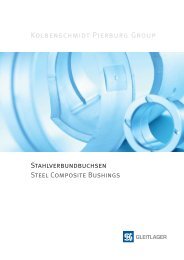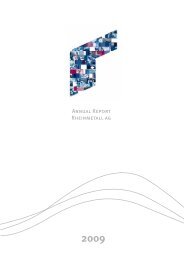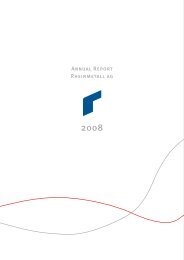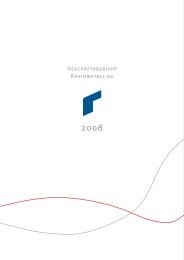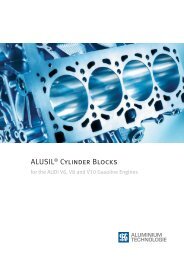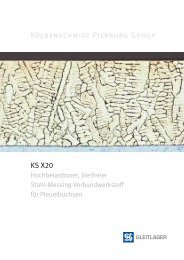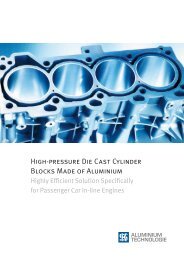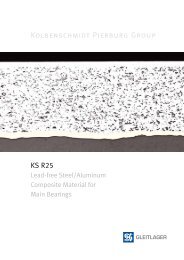Exhaust Gas Mass Flow Sensor
Exhaust Gas Mass Flow Sensor
Exhaust Gas Mass Flow Sensor
You also want an ePaper? Increase the reach of your titles
YUMPU automatically turns print PDFs into web optimized ePapers that Google loves.
Kolbenschmidt Pierburg Group<br />
<strong>Exhaust</strong> <strong>Gas</strong> <strong>Mass</strong> <strong>Flow</strong> <strong>Sensor</strong><br />
for Applications in Commercial<br />
Diesel Engines –<br />
The System for Optimizing the<br />
Emission Characteristics
Introduction<br />
In order to pay tribute to increasingly stringent emission standards<br />
in the commercial vehicle sector, heavy-duty engines<br />
have been submitted to a number of internal measures,<br />
which in combination with suitable exhaust gas after-treatment<br />
systems, represent the current and future state of the<br />
art. However, the full potential of these measures, for example<br />
cooled external exhaust gas recirculation (EGR), can only<br />
be exploited if they are properly adjusted to all engine operating<br />
conditions. This involves increased demands on engine<br />
control and consequently higher standards to be met by<br />
the sensors used in the control loop. For the future, the integration<br />
of the second combustion partner, oxygen, promises<br />
to release further engine control improvement potential. This<br />
is illustrated by the findings of investigations demonstrating<br />
that even the minutest variations in O2 concentration lead to<br />
significant changes in the level of NOx emissions, particularly<br />
at high EGR rates. In order to accurately adjust the O2 concentration,<br />
it is consequently imperative to provide for exact<br />
control of the air pathway within the engine. The definition<br />
of the exhaust gas mass flow routed to the engine which is<br />
necessary to this end can preferably be achieved by means<br />
of precise and direct measurement in the exhaust gas.<br />
The need for further, new sensor systems results from the<br />
fact that the legislation increasingly specifies that engine<br />
control should be OBD compatible with respect to the function<br />
of its individual components.<br />
NOx-Emissions<br />
(ppm)<br />
Smoke number<br />
(-)<br />
EGR rate<br />
(%)<br />
1000<br />
800<br />
600<br />
400<br />
200<br />
0<br />
6<br />
5<br />
4<br />
3<br />
2<br />
1<br />
0<br />
30<br />
25<br />
20<br />
15<br />
10<br />
5<br />
0<br />
Fig. 2: Simulated emissions at a sudden load variation C25 --> C100.<br />
Control Accuracy in Stationary and Dynamic Load<br />
Points<br />
A comparison of control concepts based on a conventional<br />
air mass flow sensor with those using an EGS shows the<br />
great potential inherent in exhaust gas mass flow sensor<br />
(EGS) technology for improving engine control. Scattered<br />
engine raw emission levels can be significantly reduced by<br />
using an EGS (Fig. 1).<br />
Particulate matter (mg/kWh)<br />
300<br />
0.95<br />
250<br />
200<br />
0.90<br />
0.63<br />
150<br />
100<br />
Concept I<br />
AMS<br />
50<br />
0.6 0.7 0.8 0.9 1.0 1.1 1.2<br />
NOx (g/kWh)<br />
Fig. 1: Measuring-system specific spread of the emission control<br />
quality<br />
Besides control accuracy, the control concepts were also<br />
analyzed in regard to their dynamic characteristics. As can<br />
be inferred from Fig. 2, the EGS concept ensures quick control<br />
response which leads to reduced NOx overshooting.<br />
The response time of the exhaust gas mass flow sensor is<br />
t 63 = 60 ms. The difference between the AMS and EGS con-<br />
Concept IV AMS Concept V EGS Concept VI Lambda probe<br />
-5 0 5 10<br />
Time (s)<br />
0.90<br />
0.95<br />
0.63<br />
Concept II<br />
EGS<br />
0.6 0.7 0.8 0.9 1.0 1.1 1.2<br />
NOx (g/kWh)<br />
3
cepts in terms of dynamic behavior is negligible. In comparison,<br />
a concept with λ-probe shows a disadvantageous<br />
behavior with the anticipated critical NOx overshoot in the<br />
case of a sudden load variation.<br />
Product Benefits at a Glance<br />
Besides high accuracy of exhaust gas flow measurement independently<br />
of gas throughput, all requirements imposed by<br />
engine operation are met:<br />
4<br />
Direct logging of the exhaust gas mass flow as control<br />
variable<br />
Simultaneous exhaust gas temperature measurement<br />
Free positioning with minimum installation space<br />
requirements allows engine-specific location<br />
<strong>Exhaust</strong> gas temperature up to 300 °C<br />
Accuracy of mass flow measurement +/- 2 %<br />
Precise control of exhaust gas recirculation in all<br />
operating ranges throughout the service life<br />
Full OBD functionality through CAN bus<br />
Meets all common commercial diesel requirements<br />
Good resistance to contamination, supported by<br />
integrated burning-off function<br />
Flexible Application of the <strong>Exhaust</strong> <strong>Gas</strong> <strong>Mass</strong> <strong>Flow</strong><br />
<strong>Sensor</strong> in Engines<br />
The exhaust gas mass flow sensor lends itself to all applications<br />
in the on-road and off-road sector which require exhaust<br />
gas mass flow control pursuant to demanding emission<br />
legislation such as Euro 6 or EPA 10/13 and/or Tier 4<br />
final.<br />
High exhaust gas temperatures<br />
Chemical resistance<br />
Insensitivity to soot load<br />
Resistance to condensate precipitation<br />
Long service life and vibration stability<br />
The exhaust gas mass flow sensor presented can be installed<br />
in existing exhaust gas ducts so that only little space is required<br />
for installing the measuring system. An uniform flow<br />
distribution in the sensor area ensures high measuring accuracy.<br />
An additional measuring section to be integrated into<br />
the exhaust gas line is not necessary.<br />
Transport and installation are facilitated by a stirrup of aerodynamic<br />
design which prevents damage to the ceramic sensor<br />
elements.<br />
Design and Function<br />
The described sensor system has the ability to determine<br />
the exhaust gas mass flow. The exhaust gas mass flow sensor<br />
consists of the sensor itself and an electronic evaluation<br />
unit which are interconnected by means of a flexible, hightemperature<br />
resistant cable. The evaluation unit is equipped<br />
with a standard plug interface which enables the system to<br />
be connected to the engine electronics. Through this interface,<br />
the essential measuring variables, mass flow and temperature,<br />
as well as all error and status messages are communicated<br />
via CAN bus (cf. Fig. 3 “Design principle”).<br />
The measuring principle applied is that of hot-film anemometry<br />
which is shown schematically in Fig. 4.<br />
51.7<br />
80<br />
Fig. 3: Design principle<br />
115<br />
<strong>Exhaust</strong> gas<br />
mass flow m<br />
Fig. 4: Principle of heated film exhaust gas mass flow<br />
M8<br />
18<br />
69 36
Engine torque (Nm)<br />
250<br />
200<br />
150<br />
100<br />
50<br />
EGR mass flow – CO 2 Reference<br />
1000 1500 2000 2500 3000 3500 4000 4500<br />
Fig. 5: Direct EGR measurement and reference<br />
The sensor consists of two sensor elements, one of which<br />
measures the exhaust gas temperature ( T a ) whilst the temperature<br />
of the other is raised ( T h ) by means of electric heating.<br />
The gas passing the heated sensor element will cause a<br />
heat loss Q which is a measure for the momentary exhaust<br />
gas mass flow. In simplified terms, the following applies:<br />
Where A stands for the flow section and c1 for a proportionality<br />
constant.<br />
The relative accuracy tolerance of non-calibrated sensors in<br />
the mass flow is below 4 % already on the flow test bench in<br />
wide ranges of the performance map. This value can be distinctly<br />
improved further by calibration. Fig. 5 shows a direct<br />
comparison of the measuring signal of the EGS with that resulting<br />
from exhaust gas mass flow measurement by means<br />
of CO2 balancing. Fig. 6 illustrates the relative accuracy tolerance<br />
of the sensors when adding a single calibration point at<br />
25 °C and 100 kg/h. In the application range, this tolerance<br />
is less than 2 % at temperatures of up to 300 °C.<br />
A further challenge for the sensor is the pulsations caused<br />
by the load cycle effects of the engine. With the implemented<br />
direction identification any backflows are recognized and<br />
the gas flows exclusively in intake direction are balanced<br />
correctly. To this end, the heating element is equipped with<br />
two temperature sensors which are arranged in tandem in<br />
the direction of flow. In the case of exclusive pulsation, no<br />
temperature difference will build up between the sensors<br />
due to the symmetric gas flow in relation to the sensor arrangement.<br />
EGS output value kg/h<br />
1000 1500 2000 2500 3000 3500 4000 4500<br />
When the sensor is operated in soot-laden exhaust gas, soot<br />
load is inevitable. As a soot deposit on the sensor elements<br />
would significantly affect the heat transmission between sen-<br />
sor element and exhaust gas, the measuring result would be<br />
intolerably biased. This distortion can be avoided by regular<br />
burning-off of the soot – a function which is already integrated<br />
in the EGS.<br />
Air mass test bench (kg/h)<br />
160<br />
140<br />
120<br />
100<br />
80<br />
60<br />
40<br />
1<br />
0.64<br />
0.55<br />
0.17<br />
0.66<br />
1.5<br />
2<br />
0.6<br />
0.21<br />
0.67<br />
0.94<br />
1.3<br />
Relative standard deviation (%)<br />
0.55<br />
0.89<br />
0.96<br />
0.82<br />
0.67<br />
0.68<br />
1<br />
1.1<br />
0.82<br />
1.1<br />
0.73<br />
0.71<br />
Fig. 6: Measuring accuracy with calibration<br />
1<br />
1<br />
1<br />
1<br />
2.4<br />
1.9<br />
0.5<br />
1.5<br />
1<br />
Air temperature (°C)<br />
1<br />
1.6<br />
1.3<br />
1.9<br />
2.1<br />
2.2<br />
1.7<br />
2<br />
4<br />
6<br />
2<br />
3.5 4.1<br />
4<br />
4.7 4.3<br />
4<br />
3.4 3.4<br />
2.1 2.8<br />
2 1.7 1.4<br />
20<br />
0 100 200 300 400 500 600<br />
1<br />
2<br />
2<br />
2.3<br />
5.3<br />
3.3<br />
4.6<br />
5
Electrical Interface – Plug & Play<br />
The sensor can be supplied with, optionally, 12 V and 24 V<br />
DC under the boundary conditions of the customary standards<br />
of industrial diesel engine applications. For communication<br />
with the engine control unit (ECU), a CAN bus or a<br />
PWM interface are available.<br />
In addition to the value of the EGR mass flow, the sensor also<br />
indicates the current EGR temperature. Via the CAN bus, the<br />
full OBD functionality is ensured.<br />
Validation<br />
The sensor was validated in engine operation. To this end,<br />
vibration and temperature cycling were tested with respect<br />
to their impact on the sensor and the measured signals.<br />
Moreover, the effect of aging was examined.<br />
The sensor has been designed for operation at fluid temperatures<br />
of up to 300 °C. As stress cracks in the ceramic<br />
material of the sensor elements due to abrupt cooling would<br />
only occur at substantially higher temperatures, condensate<br />
deposits are not problematic for the sensor. An additional<br />
tolerance increase of the sensor over its lifetime can be assumed<br />
to be less than 2 %.<br />
6<br />
EU VI<br />
EPA 10/13<br />
Tier 4<br />
Tier 4f<br />
Fig. 7: Pierburg – System supplier<br />
EGR<br />
<strong>Mass</strong><br />
<strong>Sensor</strong><br />
Actuators<br />
<strong>Exhaust</strong> Control<br />
Valve<br />
EGR<br />
Valve<br />
System<br />
Development<br />
and<br />
Manufacturing<br />
Intake<br />
Throttle<br />
Reed<br />
Valve<br />
EGR<br />
Cooler<br />
Turbo<br />
Charger<br />
Achieving Targets Systematically – Business Unit<br />
„Commercial Diesel Systems“<br />
In the ongoing endeavor to pay tribute to customer requirements,<br />
Pierburg has pooled the relevant activities in the<br />
“Commercial Diesel Systems” Business Unit. The comprehensive<br />
expertise in the area of air and exhaust gas management<br />
was combined with proven air supply products such<br />
as intake manifolds, charge air distributors and throttles, as<br />
well as pollutant reduction units like exhaust gas recirculation<br />
valves, exhaust gas coolers, exhaust gas valves, exhaust<br />
gas mass flow sensors and secondary air systems (Fig. 7).<br />
Today, these individual elements are successfully deployed<br />
in combustion engines as components and, by combining<br />
several individual products, as modules. Pierburg possesses<br />
the competence to act as your partner in engine development<br />
in facing the challenges of present and future emission<br />
limits (Fig. 8).<br />
In order to be able to warrant low development costs and<br />
high development quality, it is essential to have the right<br />
understanding of the interaction between the individual<br />
components and their impact on the processes taking place<br />
inside the engine. With its fine-tuned charging system components,<br />
Pierburg supports the engine manufacturer in this<br />
demanding optimization process.
Pierburg is a Global Player<br />
Long before the buzzword “globalization” became a dictum,<br />
it was vital for the automotive and OEM supplier industries to<br />
cross borders and establish a worldwide network of production<br />
sites. Pierburg, too, has understood and taken this trend<br />
into consideration early on.<br />
Besides the German plants in Neuss, Nettetal and Berlin, the<br />
company possesses production locations in all important<br />
automotive markets of the world. These include production<br />
plants and sales establishments in France, the United Kingdom,<br />
Spain, Italy and the Czech Republic as well as North<br />
and South America, India and China.<br />
As an innovation and technology driving system partner of<br />
the OEM, Pierburg is always close to its customers with its<br />
world-wide location concept. Moreover, the plants’ specialization<br />
and internal production network yield scale effects<br />
and synergies, enhanced efficiency and optimized flexibility<br />
Pierburg <strong>Exhaust</strong> <strong>Gas</strong><br />
<strong>Flow</strong> <strong>Sensor</strong><br />
Cyl. 1 to 3<br />
Cyl. 4 to 6<br />
Pierburg<br />
EGR Cooler<br />
Pierburg<br />
Reed Valve<br />
Fig. 8: Future engine concept (example: HDDE)<br />
Pierburg Air Throttle<br />
Pierburg Turbo Charger<br />
Pierburg EGR Valve<br />
Pierburg Bypass Valve<br />
Further locations in low-cost regions offer customers competitive<br />
products without trade-off in quality. For example, Pierburg<br />
has been established in China since 2001. The plant in<br />
Shanghai primarily caters to the Chinese market, being additionally<br />
active as a parts supplier within the Pierburg group.<br />
A similar strategy is pursued by Pierburg at the location Ústí<br />
nad Labem, Czech Republic, for the European market. Pierburg<br />
possesses a worldwide network with team spirit.<br />
Pierburg Charge Air Cooler<br />
(2 nd stage)<br />
Pierburg Charge Air Cooler<br />
(1 st stage)<br />
PierburgTurbo Charger<br />
Pierburg Waste Gate<br />
Pierburg <strong>Exhaust</strong> Flap Actuator<br />
7
Pierburg GmbH · Alfred-Pierburg-Straße 1 · 41460 Neuss · GERMANY<br />
Tel. +49 2131 520-1 · Fax +49 2131 520-645 · www.kspg.com<br />
Subject to alterations. Printed in Germany. A|IX|j







